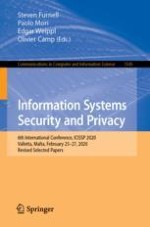2022 | Buch
Information Systems Security and Privacy
6th International Conference, ICISSP 2020, Valletta, Malta, February 25–27, 2020, Revised Selected Papers
herausgegeben von: Steven Furnell, Paolo Mori, Edgar Weippl, Olivier Camp
Verlag: Springer International Publishing
Buchreihe : Communications in Computer and Information Science
